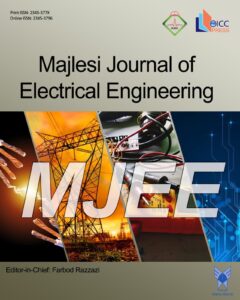6G Automatic Modulation Classification using Deep Learning Models in the Presence of Channel Noise, CFO, and PN
Authors
Abstract
An efficient and a remarkable automatic modulation classification (AMC) technique is essential with the advent of sixth-generation (6G) communication systems. Using the pre-trained convolutional neural network (CNN), a deep learning (DL) approaches to classify eight types of digital modulated signals. National Instrument LabVIEW NXG is used to build the modulation transceivers at 100 GHz a 6G carrier frequency. The dataset collected at a complicated environments including carrier frequency offset (CFO), phase noise (PN), and at distinct signal-to-noise ratios (SNR).Through experimental simulation, an improvement in the classification accuracies were achieved. In particular, the outstanding accuracy rates achieved are 98.68% and 96.05% using ResNet18 and ResNet101, respectively. Furthermore, these models have the ability to classify the modulated signals at lower SNRs. These innovative models are suitable and effective to utilize for 6G wireless communication networks.
Keywords
- Deep learning
- Automatic modulation classification (AMC)
- 6G
- Carrier frequency offset (CFO)
- Phase noise (PN)
References
[1] A. Halamandaris, “Performance Analysis of 6G Communication Links in the Presence of Phase Noise,” Ph.D. dissertation, California state Univ., Northridge, 2023.
[2] W. Xiao, Z. Luo, and Q. Hu, “A Review of Research on Signal Modulation Recognition Based on Deep Learning, Electronics,” vol. 11, p. 2764, Sep. 2022.
[3] A. Abushattal, S. E. Zegrar, A. Yazgan, and H. Arslan, “A Comprehensive Experimental Emulation for OTFS Waveform RF-Impairments,” Sensors vol. 23, p. 38, .Dec. 2022
[4] O. H. Salim, A. A. Nasir, H. Mehrpouyan, W. Xiang, S. Durrani and R. A. Kennedy, “Channel, Phase Noise, and Frequency Offset in OFDM Systems: Joint Estimation, Data Detection, and Hybrid Cramér-Rao Lower Bound,” IEEE Trans. on Comm., vol. 62, pp. 3311-3325, Jul. 2014.
[5] D. M. Ali, Z. Z.Yahya, and Y. M. Abbosh, “OTFS Waveform Effectiveness in 6G Communication Networks,” Int. J. of Microwave and Opt. Technol, vol. 18, pp. 1-6, Jan. 2023.
[6] R. N. Ipanov, A. A. Komarov and A. P. Klimova, “Phase-Code Shift Keyed Probing Signals with Discrete Linear Frequency Shift Keying and Zero Autocorrelation Zone,” presented at the 2019 International Conference on Engineering and Telecommunication (EnT), Dolgoprudny, Russia, 2019.
[7] N. Bereczki, and V. Simon “Machine Learning Use-Cases in C-ITS Applications,” Infocommunications J., vol. 15, pp. 26-43. May 2023.
[8] T. O’Shea, N. West, “Radio Machine Learning Dataset Generation with GNU Radio,” in proc. of the GNU Radio Conf., pp. 1-6.
[9] T. J. O’Shea, T. Roy and T. C. Clancy, “Over-the-Air Deep Learning Based Radio Signal Classification,” IEEE J. of Selected Topics in Signal Proc. vol. 12, pp. 168-179, Jan 2018.
[10] J. Shi, S. Hong, C. Cai, Y. Wang, H. Huang and G. Gui, “Deep Learning-Based Automatic Modulation Recognition Method in the Presence of Phase Offset,” IEEE Access, vol. 8, pp. 42841-42847, Mar. 2020.
[11] H. Zhang, F. Zhou, Q. Wu, W. Wu and R. Q. Hu, “A Novel Automatic Modulation Classification Scheme Based on Multi-Scale Networks,” IEEE Transactions on Cognitive Communications and Networking, vol. 8, pp. 97-110, Jan 2022.
[12] M. M. Elsagheer, S. M. Ramzy, “A hybrid model for automatic modulation classification based on residual neural networks and long short term memory,” Alexandria Engineering J., vol. 67, pp. 117-128, Mar. 2023.
[13] H. Han et al., “Automatic Modulation Recognition Based on Deep-Learning Features Fusion of Signal and Constellation Diagram,” Electronics, vol. 12, p. 552, Jan 2023.
[14] Y. Liu, X. Yan, X. Hao, G. Yi, and D. Huang, “Automatic Modulation Recognition of Radiation Source Signals Based on Data Rearrangement and the 2D FFT,” Remote Sensing, vol. 15, p. 518, Jan 2023.
[15] Q. Zhou, R. Zhang, Z. Jing, and X.. Jing, “Semi-supervised-based automatic modulation classification with domain adaptation for wireless IoT spectrum monitoring,” Frontiers in Physics, vol. 11, p. 1158577, Mar. 2023.
[16] Z. Z. Yahya, and D. M. Ali, “Software Defined Radio (SDR) Signals Classification via Convolutional Neural Networks,” Int. J. of Microwave and Opt. Technol., vol. 18, pp. 607-616, Nov. 2023.
[17] C. Roy et al., “An Ensemble Deep Learning Model for Automatic Modulation Classification in 5G and Beyond IoT Networks,” Computational Intelligence and Neuroscience, vol. 2021, Dec. 2021.
[18] T. T. An, A. A. Puspitasari, and B. M. Lee, “Efficient Automatic Modulation Classification for Next Generation Wireless Networks,” TechRxiv, pp.1-12, Oct. 2023.
[19] L. Guo, R. Gao, Y. Cong, L. Yang, “Robust automatic modulation classification under noise mismatch,” EURASIP J. on Advances in Signal Proc. vol. 2023, p.73, Jun. 2023.
[20] Z. Elkhatib, F. Kamalov, S. Moussa, A. B. Mnaouer, M. Yagoub, H. Yanikomeroglu, “Radio Modulation Classification Optimization Using Combinatorial Deep Learning Technique,” IEEE Access, vol. 12, pp. 17552-17570, Jan. 2024.
[21] J. Jang, J. Pyo, Y. -I. Yoon and J. Choi, "Meta-Transformer, A Meta-Learning Framework for Scalable Automatic Modulation Classification," IEEE Access, vol. 12, pp. 9267-9276, Jan. 2024.
[22] S. Mohsen, A M. Ali, A. Emam, “Automatic modulation recognition using CNN deep learning models,” Multimedia Tools and App., vol. 83, pp. 7035-56, Jan. 2024.


